(English follows German)
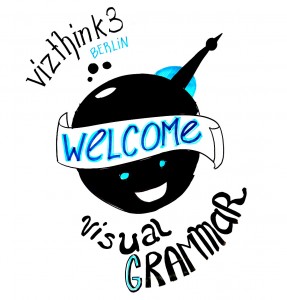 Am 5. Juni fand unser drittes Meetup in der Humboldt Viadrina School of Governance statt – eine weitere inspirierende Veranstaltung mit mehr als 40 Teilnehmern. Wir hatten sogar Gabriele Schlipf als „Hauptgang“ und sie brachte uns bei, wie man sich gut in visueller Sprache zurecht findet. Ja, das Thema war „visuelle Grammatik“.
Am 5. Juni fand unser drittes Meetup in der Humboldt Viadrina School of Governance statt – eine weitere inspirierende Veranstaltung mit mehr als 40 Teilnehmern. Wir hatten sogar Gabriele Schlipf als „Hauptgang“ und sie brachte uns bei, wie man sich gut in visueller Sprache zurecht findet. Ja, das Thema war „visuelle Grammatik“.
In unserer Aufwärmübung “Circle-Jam”, haben wir mit einem einfachen Kreis gearbeitet, um ein neues Bild daraus zu kreieren. Was kann ein einfacher Kreis sein? Die Erde? Ein Ball? Allein dies ist schon ein Beispiel visueller Grammatik. Es zeigt uns einen gemeinsamen Referenzpunkt, um aus zufälligen Dingen unserer täglichen Kommunikation Sinn zu machen.
Dann wurden wir wie immer visuell einander vorgestellt, dieses Mal jedoch mit der kleinen Änderung, etwas über sich selbst zu sagen, dass noch niemand im Raum weiß. Wir haben die Teilnehmer auf die lustigsten Arten kennen gelernt – von wahren Geheimnissen, bis hin zu dem, was sie zum Frühstück hatten. Das Eis war bereits gebrochen, aber das hat hier und dort zu weiteren Lachern geführt!
Ok – aber lasst uns nun die Grammatik angehen!
Um darzustellen, was visuelle Grammatik wirklich bedeutet, hat Gabriele einige ausgezeichnete Übungen vorbereitet.
Übung 1: Körpersprache
Zuerst versuchten wir, eine Linie zu bilden, um unser Wissen von visueller Sprache zu zeigen. Wenn jemand denkt: „Ich kenne sie sehr gut und weiss, wie man sie verwendet!“, bewegt er sich an ein Ende der Linie. Jemand, der denkt „naja, ich bin nicht so gut“ stellt sich ans andere Ende. Es stellte sich heraus, dass wir keine gerade Linie bildeten, sondern uns quer im Raum verteilten, um uns genau relativ zu den anderen zu positionieren und damit zu zeigen, wie wir als Gruppe unser Wissen zu visueller Grammatik einschätzen.
Wir haben uns zweitens leise im Raum verteilt, ohne einander zu berühren. Erneut konnten wir das schaffen, in dem wir visuelle Grammatik anwendeten. Körpersprache ist visuelle Kommunikation – wie wir uns zueinander stellen (Positionierung, Raumteilung) ist visuelle Kommunikation. Wie weit entfernt? Wie nah?
Als Gabriele zu erklären begann, bildeten wir automatisch einen Kreis, um ihr zuzuhören. Sogar das ist eine bestimmte Form der Grammatik. Wir kreieren einen Satz zusammen. Das können wir ohne Anweisungen tun, da wir intuitiv die Grammatik kennen, die in bestimmten Umständen wirkt.
Übung 2: Konjugation
Wie Verben, so können wir auch visuelles konjugieren. Wir geben eine Richtung vor (rechts nach links, links nach rechts, unten nach oben), fügen eine Dimension und eine Bewegung hinzu (einander berühren, vorne und hinten), verändern den Umriss, um ein Symbol mit sozialer Bedeutung zu formen und erzählen eine Geschichte damit. Ein Kreis impliziert die Erde oder einen Ball. Ein Quadrat erinnert uns an ein Haus. Ein Kreuz suggeriert Verbindung, ein Pluszeichen, oder das Rote Kreuz. Visuelle Grammatik lässt uns die Beziehung, Richtung, Bewegung und Aktion von einfachen, rohen Formen hinzufügen. Erstaunlich!
Übung 3: von den besten Künstlern lernen
Wir haben uns Kandinsky und Da Vincies Bilder angeschaut, um zu erfahren, welche visuelle Grammatik sie verwendeten, so wie den goldenen Schnitt. Woher wissen wir, welche Frau Maria ist? Durch ihre Position im Bild.
Übung 4: Tomaten Auf den Augen
Was sollen wir sagen, wenn wir Jemandem, der sie noch nicht sehen kann, aber zeichnen muss, eine Visualisierung erklären müssen? Dieses Spiel prüfte, wie gut wir visuelle Grammatik in Worte fassen können!
Eine Person beschreibt ein Bild mit Tomaten, ohne den Stift des anderen zu berühren.
Die andere Person zeichnet anhand der Beschreibung des Anderen ein Bild mit Tomaten, ohne auf das Bild zu schauen. Was für eine Herausforderung!
Drei Stunden gingen so schnell vorüber!
Dank an alle für Eure Mithilfe und das Ermöglichen der Veranstaltung. Ihr könnt alle Bilder hier sehen.
Das nächste Treffen am 06. August wird im Impact Hub Berlin in Neukölln stattfinden und unser Gast Conni Eybisch-Klimpel wird über das Thema „wie man zuhört, während man Notizen in Form von Skizzen macht“ sprechen.
Vielen Dank auch für die freiwillige Mitarbeit, dieses Treffen mit neuen wichtigen Personen in der Szene zu organisieren.
vizthink.de dreht sich in der Tat hauptsächlich um die Gemeinschaft und das gegenseitige Helfen, Teilen von Ressourcen und kreieren aufregender Treffen rund um das Thema visuelles Denken.
(English)
On June 5th, our 3rd Meetup took place at Humboldt Viadrina School of Goverance – another inspirational evening with 40+ participants. We had Gabriele Schlipf as our “main dish” and she thoroughly taught us how to have a good command of visual language. Yes, the topic was “Visual Grammar”!
In our “Circle Jam”warm-up exercise, we elaborated on a simple circle to create a new image out of it. What can a plain circle be? A face? The Earth? A ball? This is already an example of visual grammar. It gives us a shared reference point to make sense out of random things in our daily communication.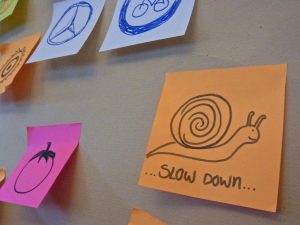
Then, as always, we visually introduced to one another, this time with the slight twist to say something about yourself that nobody else in the room knows yet. We really got to know the participants in the funniest ways – from real secrets to what they had for breakfast. The ice was already broken but this caused a good additional laugh or two here and there!
Ok. But now let’s tackle the grammar!
To illustrate what the visual grammar really means, Gabriele had prepared various excellent exercises.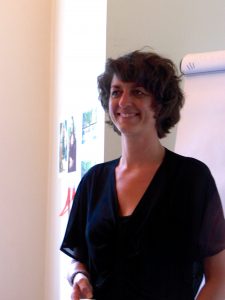
Exercise 1: Body Language
Firstly, we tried to make a line to show our proficiency in visual language. If one thinks “I know it really well and how to use it!” then one goes one end. One who thinks “Na ja, I suck,” goes to the other end. What turned out is that we didn’t make a straight line but were scattered in the room to precisely position ourselves in relation to the others and display how good or bad we think our grip on visual grammar is.
Secondly, we walked around in the room quietly without touching each other. We could accomplish this task because we used visual grammar, again. Body language is visual communication, how we place ourselves apart from each other (positioning, spacing) is visual communication. How distant? How close? Once Gabriele began explaining, we automatically made a circle around her to listen to her. Even this is a form of grammar. We make a sentence together. We can do it without instructions because we intuitively know the grammar that works under certain conditions.
Exercise 2: Conjugation
Like a verb, we can conjugate visuals. We give a direction (right to left, left to right, bottom to top), add a dimension and a movement (touching each other, front and behind), alter a shape to make a symbol that has a social meaning, and tell a story with them. A circle implies the earth or a ball. A square reminds us of a house. A cross suggests connection, a plus, or the Red Cross.Visual grammar enables us to add the relation, direction, movement, and action to simple, plain shapes. Amazing!!!
Exercise 3 : Learning from the master artists
We looked at Kandinsky and Da Vinci’s pieces to learn which visual grammar they used, such as the golden ratio. How do we know which female Maria is? Because of the position of Maria in the painting.
Exercise 4: Tomaten Auf den Augen („Tomatoes on the eyes“)
What shall we say when we have to describe a visual to someone who can’t see it yet is required to draw it? This game tested us how well we could put the visual grammar into words!
One person describes a picture of tomatoes without touching the other’s pen.
The other person draws a pitcure of tomatoes based on the partner’s instruction without looking at the picutre. What a challenge!!!
Three hours flew so fast! Thank you everybody for contributing to make it happen. You can view all the photos here.
The next meetup on August 6th will be at the Impact Hub Berlin in Neukölln and our guest Conni Eybisch-Klimpel will talk about „How to listen when Sketch Noting“. Thank you also for stepping foward to organize this meetup with new players in the game. Because vizthink.de is indeed all about the community nurturing each other, and sharing resources, creating exciting gatherings around the theme of visual thinking.
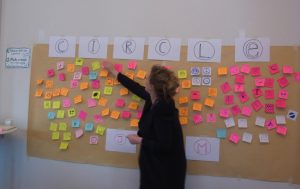

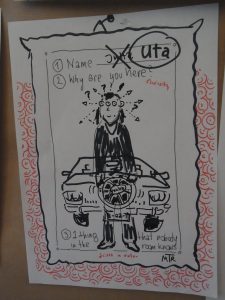
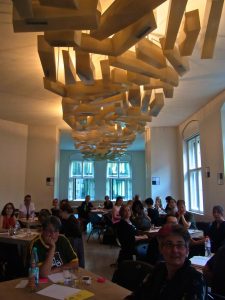
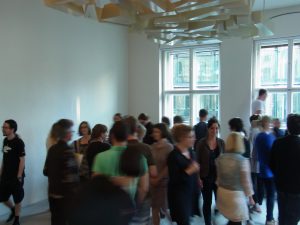
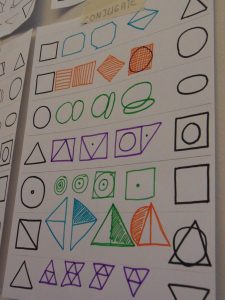
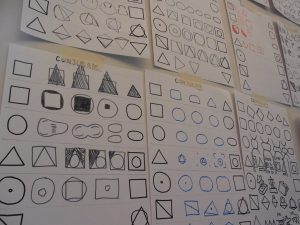

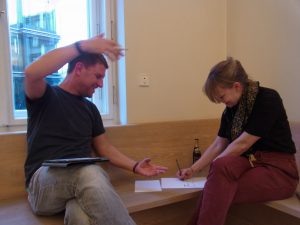

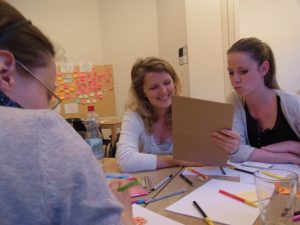
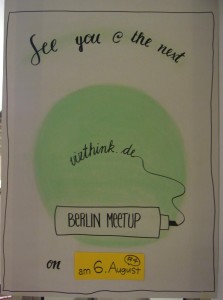
Comments are closed